This page is a series of notes about the recent (late
January, 2001) ski trip we took to our sister city of St. Moritz in Switzerland.
Some of the information contained here may be useful to a reader contemplating a ski trip
to Europe in general or this resort in particular.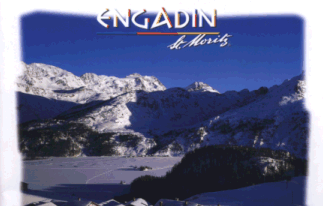
Click the following links to jump to various bookmarked sections:
Getting there, lodging, weather, food, the skiing, types of equipment used, safety issues, ski instruction and guides, European skiers, different ski areas, slope maintenance, uphill transportation, snow quality, the "big picture" ski experience, other entertainment, comments on local architecture, out on the ice, the automobile situation, bus transportation, walking around town, cross country skiing, the swimming pool, race start for the 2003 World Championships, the shopping.
Our flight progressed from Denver to Chicago & then on to Zurich by Swiss Air. It’s a long trip but was somewhat easier to handle than we had anticipated. There’s a eight hour time differential between Vail & St. Moritz. Face it, unless you’re traveling by private jet, it’s pretty much an all day ordeal, but the trip was made easier by taking a legal drug called Ambien. It was recommended to us by a friend who commonly travels the world over. Taken on the longest leg of the flight, it basically put us under for 4-5 hours & we awakened without the hangover normally associated with sleeping pills.
From Zurich to the destination it’s another three hours by bus or van over some truly difficult roads. The highways in Switzerland are fine, but going over these kinds of mountain passes in a driving snowstorm is an experience all of us could have done without. While the roads are paved & wonderfully maintained, the major highway occasionally becomes a one lane road going through some of the smaller towns – the prospect of which would be unthinkable in this country.
If you are traveling by private jet, St. Moritz does offer a public airport just three kilometers from the heart of town, but it’s VFR only, so if bad weather conditions exist, be prepared to fly to Zurich & van your way over.
Our group was booked into the Park Hotel Kurhus. It’s classified by some organization as a four star hotel – and it very well may be so by some standards. By U.S. standards this definitely was an older, but well maintained facility.
We chose the economy room for our stay and really didn’t regret the choice. It contained a king sized bed, writing desk, small cocktail table, easy chair, small refrigerator, and television. The bathroom had a shower & the other related facilities. Storage was adequate, if not extensive. Clearly this is an older hotel but one to which we would probably readily return under similar conditions. Cleanliness was excellent, and daily maid service was fine. We left the obligatory dollar on our pillows each day when we left for skiing.
Even though gratuities were built into our package price, we did opt to tip a couple of the better waiters early in our stay and it paid off in a noticeably better level of service through the week.
The more upscale hotels in town would clearly be the famous Palace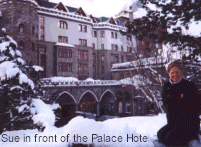 and the Suvretta House, the latter of
which might be the better choice, as it is ski in/ski out.
We only looked at one other smaller accommodation – that being the Noloa, and
it seemed to be another wonderful choice all other things being equal.
and the Suvretta House, the latter of
which might be the better choice, as it is ski in/ski out.
We only looked at one other smaller accommodation – that being the Noloa, and
it seemed to be another wonderful choice all other things being equal.
While St. Moritz is classified as a very upscale resort, there apparently are plenty of pensions and hostels that would offer economical stays for anyone willing to sacrifice some of the creature comforts we desired.
For the most part the mountainous regions of Europe are significantly lower in elevation than here in the Colorado Rockies. St. Moritz advertises itself as “Top of the World” and that probably is the case in this part of the continent. We drove (were driven) through a major winter storm to get to the Engadin from Zurich. This was in late January. Driving can be difficult. Passes are commonly closed from several hours to several days due to slides as was the Julierpass (for three days the week before) we transited on our way to the Engadin valley.
There was roughly seven inches of snow the day we arrived and a couple more inches the day we left – a week later. That’s not a lot of snow, but it’s what we were blest with and probably pretty much normal snowfall for the area.
The high, basically treeless ski slopes which dominate this region lend themselves to windy conditions. We experienced that particular weather phenomenon virtually every day we were in the Alps. It was really cold on the windy, exposed slopes of the mountains – not a dry cold as we have in Colorado – but a moist cold that got into the bones quickly. Happily that weather element provided an incentive to periodically head to a nearby mountain restaurant that served delicious hot chocolate or rich, strong coffee.
So dress properly for all conditions or suffer the consequences.
We basically enjoyed everything we ate, not only because it was pleasurable, but because of the slight differences from our domestic cuisine. Our breakfasts & dinners at the hotel were pretty much prix fixe due to our American Plan arrangement.
Breakfasts were buffet style. The anticipated European sausage slices, cheeses, various breads & rolls were served as were a variety of flavored yogurts which apparently are popular. But there were also three minute eggs, five minute eggs, cooked link sausages, scrambled eggs, limp bacon strips, toast, cereal, various fruit cups, plus juices. Many jams & jellies were offered along with plenty of butter. The coffee, of course, was outstandingly strong & rich.
Dinners were fixed three course meals and all were very well done. The wine list was reasonably priced and as extensive as might be expected. Our assumption was that other hotels of similar same rating probably provided acceptable dining too.
Normally we stopped skiing at 1-2:00 in the afternoon and took a quick lunch break back at the hotel. The local breads, rolls, cheeses, and sausages were simply too outstanding to pass up – and they helped us avoid the interminably long lunches that seem to be such an important part of the other tourist’s mountain experience.
Our one lunch on the hill at the restaurant in the terminal of the
Piz Nair lift was simply outstanding. The
problem was that it included wine & took so long to consume that we basically had to
ski off the mountain immediat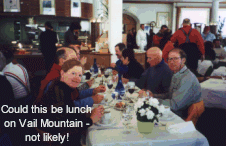 ely
following its completion.
ely
following its completion.
We took only one dinner away from the hotel – and it was outstanding – frankly as fine a meal as I’ve had – period. The restaurant was the Chesa Veglia Grill. It’s located in a mid 1600’s building that’s been lovingly restored & maintained. The ambience was wondrous & seems even more so in historical perspective. Apparently the operation is under the management of the nearby Palace Hotel. Without gushing ad nauseum about the quality of the service and food items, suffice it to say we would gladly repeat the meal on a return to St. Moritz. The meal clearly was costly . The wine list was significantly overpriced. Dinner for four of us with two very modest bottles of wine ran 550 Fr. That can be converted to U.S.A. currency as the exchange rate was roughly 1.63 Fr. to the dollar.
The friend who gave us the advice on this restaurant also recommended the Restaurant Chasellas near the Suvretta House. Since this friend’s wife grew up in Italy and spent winters in St. M., the suggestions are invaluable.
Dress is substantially more formal than in most American resorts. Coat and tie will be a requirement at this or similar quality restaurants – and even at the hotel dining rooms.
We also had one wonderful lunch at the restaurant located in the top terminal of the funicular. Normally our lunches occurred after we left the mountain, since we are not want to waste that much time eating – unlike our European cousins.
Dining on the mountain is diametrically opposite what we experience here in the states. Although our experience was limited as noted above, it’s likely that most of the other on mountain cabins offered equally delicious fare. Even the “fast food” section of the small restaurant at the top of the tram in Corvatsch at had character an order of magnitude beyond anything comparable in this country. We simply don’t do food in the US like they do it over there. Enough said. By the way the tap water everywhere is fine, even though most people still preferred bottles.
This issue is addressed repeatedly in later parts of this article. As much as we wanted to be overwhelmed by the scope & variety of a ski experience in St. Moritz, the reality is that we truly do have much better skiing, more diversity, and infinitely better snow conditions here in Vail, Colorado, USA.
Several of our European lift riding companions indicated that snow depths in the Engadin were the best in many years. While we recognized the good snow cover, the overall quality of the surface was marginal at best – compared to what we’re used to here at Vail. The fact that few visitors to St. Moritz bother to venture off piste contributes strongly to the lack of bumps and other interesting design elements to the terrain just outside of the perpetually groomed boulevards that basically defined all the areas we skied.
In all honesty, unless a person is addicted to wonderfully groomed boulevard skiing, there simply isn’t enough challenge over here to justify more than a long weekend of cruising. The other reality is that there is plenty of off piste “adventure” skiing to last a lifetime if one simply has the balls & skills & willingness & money to hire a guide to enjoy it.
The skiers here appear to be pretty conservative equipment-wise. Nothing special in the way of boots or skis really stood out. There were, however, what I would consider unusually large numbers of older white Salomon rear entry boots which was surprising. Those boots were nearly always accompanied by older, traditional, long, straight skis. We were somewhat surprised at the dearth of Strolz boots, thinking that at this upscale level of resort, surely that wonderful boot would be present in greater numbers.
Once in a while a skier would pass by or would be seen in the lift line in a truly unusual ski – very long – very wide – or very, very something else that I’d not see here in the states. It was a rare exception. Our own choice of skis for the trip were Volant Ti Powers. The added width was very helpful when we chose to go off piste.
Instructors more or less universally were using the shorter, more radically shaped carving skis. Very few Goode poles were in evidence although one instructor noted that he’d had a couple pair, but they were quickly stolen from him, so he’d not bothered again to replace them.
Ski clothing was clearly different from here in the states. The jackets are insulated, straight shaped, longer than what we normally wear in Colorado – covering the bottom, & the pants were loose fitting. Stretch pants were seldom in evidence – sadly. The clothing was attractive, but one always could recognize the European style from those from other continents – namely us.
There are many of these concerns while skiing in St. Moritz & probably even more of them in the less developed resorts in Europe. Ski Patrol as we know it in this country does not exist. There is a patrol presence some place on the mountain, but it basically is invisible. We saw only one emergency phone – although others must surely exist – please Lord!
Off piste skiing can be extremely dangerous even right next to a perfectly groomed run. The higher, steeper off slope skiing should probably not be attempted without the presence of a guide. Even with a guide, should a slide occur, the probability of a quick rescue attempt is marginal. Given the completely treeless, open terrain, the possibility of another person triggering a slide while skiing hidden from above you is always a strong possibility.
Our first day in the valley saw the only decent snow of the trip, and those seven inches were dense enough to almost be unskiable. All day long we heard and saw, helicopters in the air. At first we thought they were taking people heli-skiing, but later came to understand that these flights were basically all ambulance flights. To become injured while skiing here must inevitably be a ferociously expensive event.
We did not take our cell phones along due to the different European operating technology. The next time we’d rent local ones - at any cost – not only for use in hooking back up after the inevitable separations on the slopes, but more importantly as a critical safety measure.
Unlike in the states, where the ski school is owned and operated by the area management, in Switzerland, there was no central control of instruction. We saw perhaps a dozen different instructor uniforms on the mountain – and these uniforms were labeled variously as “Engadin Snow & Fun”, “Palace Hotel”, “St. Moritz”, “Pontresina”, etc.
Most of the instructors we watched appeared competent although no more so than here in Vail. My expectation was that we’d see a far higher level of ability here.
It’s possible that the guides who spend more time instructing off piste are higher level, and that was more or less confirmed by some of our group who did go into more difficult conditions with a guide each day.
The general focus of instruction – at least at this particular ski resort – appeared to be on carving fairly radical turns on perpetually groomed slopes. For the most part instructors used shorter (157-177 cm.) shaped skis & as often as not, also did not use poles. We were particularly struck by the fact that virtually no instruction was given off piste – something that would be unthinkable at our resort here in Colorado. Again it’s probably the nature of the St. Moritz client that they simply don’t want to ski difficult or dangerous snow. This perception ran sharply counter to what our expectations were of European skiers, but again, it may simply be the nature of this resort’s clientele.
Sue & I opted to test the slopes above St. Moritz by ourselves before committing to the guided situation. Since found we could get around quite easily on our own, we passed up going along with the others with a guide. However, because of the obviously difficult and often dangerous nature of some of the off piste terrain, we probably missed out on attempting to ski certain areas because of fear of the consequences.
Quality of the European skiers and what they like to ski
As our experience was limited to only the Engadin Valley resorts, these observations may not be indicative of the universal level of skiing throughout Europe. On balance the Europeans ski faster and with more skill than in this country. The overall skill levels are higher but those abilities seemed to be more narrowly structured than here in Vail. The people tend to ski much faster on the broad groomed runs that exist in the Engadin, and they also are more competent at avoiding collisions than here in Colorado.
One of the problem issues in Vail is that there is a greater commingling of lower level with higher level skiers on all of our intermediate runs – which fact inevitably leads to more potential conflicts in the spaces.
However, our observations of skiers attempting the few bump fields that existed indicated that the Europeans (at least here) truly lacked competence in skiing moguls. The same appears to be the case when it came to spending time off piste or in areas of what we would simply call “crud”. The Swiss resort skiers, with extremely few exceptions, absolutely avoid that type of terrain and snow condition. So while we saw better skiers on balance, their skills appeared to be very narrowly focused.
The snowboarders over there also have good cruising skills and seem to be more conscientious about collision avoidance. Carving boards are more commonplace.
We spent the first three days exploring the slopes above St. Moritz Dorf. These are South facing, wide open, treeless snowfields served by the most advanced lifts we found in the area.
The sub areas were called Marguns, Corviglia, Suvretta, Salastrains, Chantarella, and Celerina. While generally steeper than Vail, the terrain was very rolling and was filled with wide boulevard-like groomed runs. We found only one small bump field. There’s an enormous amount of off piste terrain, but much of it was very dangerous due to the probability of slides – or to the quality of the snow surface – or both. We skied as much of the untracked snow as we could albeit with a constant awareness of the risks involved.
After three days of being alternately bored or terrified, we
abandoned St. Moritz for Corvatsch.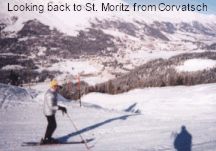 This was more like it. Corvatsch & neighboring Furtschellas are
strictly North facing, much colder, but held the snow a whole lot better. Besides, the two trams to the top of Piz Corvatsch
were stunningly high off the ground which fact caused me no small amount of cold sweat.
This was more like it. Corvatsch & neighboring Furtschellas are
strictly North facing, much colder, but held the snow a whole lot better. Besides, the two trams to the top of Piz Corvatsch
were stunningly high off the ground which fact caused me no small amount of cold sweat.
The run down Georgi’s from the top of the Piz made 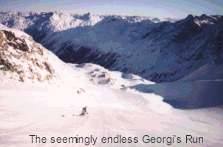 real my preconceptions of what European
skiing was supposed to be like. The vistas
were magnificent, the run groomed to perfection, and we had the place virtually to
ourselves. We did the run only once on each
of our visits to this area, but it was breathtaking each time.
real my preconceptions of what European
skiing was supposed to be like. The vistas
were magnificent, the run groomed to perfection, and we had the place virtually to
ourselves. We did the run only once on each
of our visits to this area, but it was breathtaking each time.
Generally we rode the lone chair in Corvatsch or a couple of t-bars before heading West to Furtschellas. The nicest little bump run we found in Switzerland was just off the main groomer here. We also broke around a lightly marked closure and had a couple hundred yards of bumpy tree skiing here as well. Closures are only for guidance!
Furtschellas is dominated by surface lifts. Some of us liked the t-bars – others did not. However, we probably found the best off piste snow fields of the trip here. Even five days after the only storm of the week we found completely untouched snow in several spots – the best chop existed right underneath the lone chair just above its lower terminal.
Almost the nicest thing about skiing the above two areas is that one can then ski home directly to St. Moritz and more specifically our hotel – the Park Hotel Karhus. While I can’t remember the specific name of the lift that takes one to the trail leading back to St. M., suffice it to say it is the furthest Eastern lift that is accessed by skiing in that direction from the top of the lower tram at Corvatsch.
The lone trail heading back to St. Moritz is rated Black Diamond, but the rating is difficult to understand. Normally in Europe a Black run would be due immense respect – and perhaps this one is – under adverse snow conditions. Our experiences were that it could be a long Blue run by our standards – with maybe a black face here & there. We were, however, careful to use this egress run before the big crowds at the back end of the day made the slope crowded and thus dangerous.
To be completely honest we were stunned by the amount of grooming being done in the various areas we skied. Without having experience at other European ski areas our suspicion is that the more upscale clientele of St. Moritz probably demands better conditions and this fact contributes to a higher level of snow smoothing. It was particularly fascinating to have this high level of grooming because virtually all of the skiing occurs above tree line which means a skier can venture everywhere without limits – safety considerations being the only restriction.
Broad boulevards of terrain are clearly marked with permanent poles and every one of these runs are groomed nightly as best we could tell. How the operators are able to muster this much grooming equipment and do this comprehensive work on a daily basis is stunning. It would be unthinkable to have this level of slope maintenance here at a ski area in this county – at least one of any decent size.
The unfortunate reality is that there was a downside to the grooming. While it made for faster cruising, the sameness of the conditions very quickly became boring to those of us used to more variety.
Lifts and other ways up the mountain
What a variety of uphill transportation! We rode 80 and 100 person trams, a spectacular funicular, a six person gondola, four and six person bubble covered detachable quads, two, three, and four person attached chair lifts, the ubiquitous t-bars, and poma’s. The most good chairs were out of St. Moritz Dorf in the terrain above the village. We found t-bars to be dominant at Furtschellas, but every area we visited had access to at least one bubble covered chair & of course, some type of spectacular tram.
Entry to many of the chairs & t-bars was through a fixed turnstile-like system where the pass had to be automatically scanned prior to getting on the lift. It was interesting that the scanning system could automatically count all passages & would terminate entrance to a tram or funicular after the maximum number of persons had passed through the turnstiles.
Virtually all the chair lifts were further controlled by an automatic “paddle” gate which opened to allow the three to six persons to enter the loading areas simultaneously. It then closed to prevent too many persons from entering the loading zone. This system works great and really cuts down on the number of persons failing to get to the loading line – which in turn reduces the lift stoppages due to poor loading practices on the part of the guests. Personally I’d like to see this used in our country.
My major concern about skiing in Europe – the purported rudeness in lift lines – ended up being a great big worry about nothing. With only a couple of exceptions during the week, we experienced as much politeness as would exist in this county under much more controlled circumstances. Although all the lift entries were “scrambles”, there was fairly universal patience at the entries. We might attribute this to the smaller low season crowds or simply the higher quality clientele skiing here.
This was something of a disappointment given the relatively high base area of this valley (roughly 6,200 feet), but then, we’re spoiled here in Colorado. As we were first being driven in to St. M., the area received an estimated 6-8 inches of dense, fairly high moisture content snow. While not like the Sierra cement experienced on the West Coast of the U.S., this snow was very difficult to move around – and that was it for new snow during our stay. As the week progressed and winds picked up, the off piste conditions pretty much deteriorated on a daily basis. We were able to find small pockets of decent conditions, but those “discoveries” were few & far between.
The most disappointing (for me) part of the skiing is what I’d term a lack of variety. The incredibly comprehensive grooming provides boulevard conditions in most of all the mountain areas. On the open expanses the “gaps” between the groomed runs were filled with very difficult, basically untouched sections of choppy snow, and while we were able to somewhat enjoy those off piste places, the fact that literally none of the other ski population was out there meant that those “gaps” never were skied into any kind of reasonable shape.
With only two minor exceptions we found no bump fields - a fact that seems almost unbelievable given the vastness of the terrain we covered. To put that latter statement in perspective we estimated that all of Vail’s 5,000 acres would be the equivalent of a postage stamp sitting on a full sized envelope of the Swiss terrain we skied.
All of the apres ski and late evening musical/dance activities exist here as they would in most ski resorts. Specific to this particular valley would be World Cup Races, the famous Cresta bob sled run, ski jumping events, polo matches on the ice, horse racing on the ice, etc. A music festival is held in April.
What a strange blend of utterly charming and unique very old truly
Swiss mountain dwellings and commercial buildings in the “Dorf” section that
contrasted sharply with ugly, blocky, concrete apartments that looked like they were
straight out of a post war Eastern Block country in the “Bad” section of town. 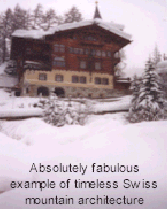
Homes along the lake and on the hillsides appeared to hold to “alpine mountain” styles with stucco dominating as an exterior finish – even though the design elements were based on individual owner tastes. A “design review” process must exist for new construction, but it appears to be extremely flexible.
It’s obvious that the construction standards for snow loads are much higher in Switzerland than they are in our part of the states since it was apparent that roofs were seldom if ever shoveled clear of snow. The four to six foot sheet of compacted ice topping almost all the buildings had to contain an incredible amount of weight. Clearly these structures are designed to last hundreds of years if need be.
On the ice
The narrow valley of the Engadin is filled with a series of lakes & impoundments. In the winter months these ice covered stretches become an extension of the land and many activities occur on the frozen surfaces. In St. Moritz hiking and cross country trails simply extend outwards from what would be a shoreline in the summer. Horse races, sleds, dog walk areas, and even a major tented food festival was held on the local lake.
There may be more high end European vehicles in St. Moritz alone than there are in the entire state of Colorado. Very few SUV’s as we know them were in evidence. We saw hordes of Mercedes, BMW’s, Opals, Audi’s, etc. Most were conventional sedans or wagons – most had ski racks on top & many were fitted with chains. We also saw a number of versions of my own car – a Subaru Impreza, but strangely no full sized Outback’s. One of our crew said they saw a U.S. Jeep, but that was it for American cars.
Buses rule! Every vehicle defers to the buses – local or long distance. The valley system seems a bit complicated. Visitors don’t receive the same kind of ski pass as the locals get which allows them (the locals) to ride the buses for free.
Riders can buy passes to different areas of the valley using the automated machines at each stop. Franc coins are used to purchase. As an example, it cost 3.6 Fr. to get to Corvatsch per person. The driver doesn’t collect tickets – he merely looks at them to make sure persons have them. To avoid paying for the bus, get on the rear entry door. Be cautious if attempting this as there is a 60 Fr. penalty if a bus examiner happens to be on that particular vehicle and checks you for a ticket and you don’t have one.
Everyone walks everywhere. The streets & sidewalks are slippery, and the terrain is hilly. I went down hard once myself. Take – or buy – good cleated shoes. All or most of the locals also use a walking stick or a pair of shorter ski poles. It’s fascinating to see the age of some of the walkers.
The number of people who engage in skate skiing and classic cross country skiing is astonishing. One would imagine being in Sweden or Norway. Tracks are perfectly maintained, groomed continually, and easily handle the hoards of persons that use them daily. There is a modest weekly or annual fee collected for using the facilities, but the collector departs by 3:30 in the afternoons. A full service waxing, rental, sales center is located in the Park Hotel at the primary starting point of the circuit. There appear to be several dozen kilometers of prepared tracks throughout the area. A world renowned major cross country event is held annually in the spring.
A wonderful public 25 meter pool is located near the Park Hotel in Bad. If you’re staying in a local accommodation, take proof of that and the only cost to use the pool is 2 Fr. Sauna’s, massages, etc. may be obtained here. For lap swimming try to get in the pool before 3:00 or so to avoid crowds.
The 2003 World Alpine’s will be held at St. Moritz. A new downhill course is being constructed for the event. The race start is situated spectacularly above the middle tower on the Piz Nair tram. Should you be in the area you can see a red marker on the sheer cliff of rock above the tram cable. It looks like free fall coming out of the gate.
Not a subject that is generally near or dear to the male heart. Nonetheless, I'll have to admit that it is really a lot of fun engaging in that "sport" here in St. Moritz. For the females on the trip it probably was more delightful, but I did enjoy going in most of the shops too.
Probably my favorite would be described as your friendly neighborhood
grocery store – AKA the “Co-op”. 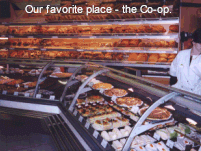 A combination of gourmet
grocery, delicatessen, konditorei, liquor store, department store, bakery, etc., this
place had everything. We loved the cheeses,
breads, rolls, chocolates, olive varietals, wines, flowers, and basically everything
else. It was a daily visitation. The wine prices were relatively economical by our
standards & far below what we’d expected to encounter here.
A combination of gourmet
grocery, delicatessen, konditorei, liquor store, department store, bakery, etc., this
place had everything. We loved the cheeses,
breads, rolls, chocolates, olive varietals, wines, flowers, and basically everything
else. It was a daily visitation. The wine prices were relatively economical by our
standards & far below what we’d expected to encounter here.
In “Dorf” there were wondrous upscale designer clothing, leather, & shoe stores. We loved the chocolates & other incredible edibles at Hansleman’s across from the Palace Hotel. My personal favorite sports shop was Boom Sport down in “Bad” near the Victoria Hotel. Bell was our daily “konditorei” stop. A rarely open fish market labeled something like “Pisces, Pasta, & ????” was on the walk downhill from Dorf to Bad & had outstanding live fish, lobster, pasta, & strangely, some outstanding wines including excellent values of well known labels from California.
Basically I really enjoyed the shopping here. Interestingly, what somewhat constrained our buying was the lack of a “Mail Boxes R Us” type of shop that did packing and shipping. Had we found such a facility our credit card limits might have to be raised.
Would we return here? Thirty days after getting back to Vail, that still remains an interesting question. Clearly we’d like to try skiing other areas of Europe, but the overall experience of being in such a stunning mountain setting makes this resort a very attractive return possibility. If St. Moritz had even nominally the variety of terrain as Vail, the question would not need to be asked.